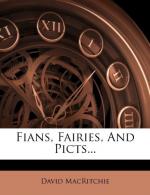[Footnote 51: Proc. of the Soc. of Antiq. of Scot., vol. iii. p. 141: also vol. vii. p. 191. This quotation is made by the late Captain Thomas, R.N., a sound archaeologist; but I have to add that in the document of 1443, as given in Barry’s Orkney (2nd ed., London, 1808, pp. 401-419), while I find the statement as to the two native races, I find nothing about the stature or habits of the Picts. Captain Thomas twice quotes his statement, and as at one place he refers, not to the Bishop of 1443, but (vol. iii. p. 141) to “the Earl of Orkney’s chaplain, writing about 1460,” it is possible he had two manuscripts of the fifteenth century in view.
[SUPPLEMENTARY NOTE.—The Bishop’s words are as follows:—
“Istas insulas primitus Peti et Pape inhabitabant. Horum alteri scilicet Peti parvo superantes pigmeos statura in structuris urbium vespere et mane mira operantes, meredie vero cunctis viribus prorsus destituti in subterraneis domunculis pre timore latuerunt.”—From his treatise De Orcadibus Insulis, reprinted in the “Bannatyne Miscellany,” 1855, p. 33.]]
[Footnote 52: Testimony of Tradition, pp. 58-60, 65, 67-74, 79-80.]
[Footnote 53: Pennant’s Second Tour in Scotland; Pinkerton’s Voyages, London, 1809, p. 368.]
[Footnote 54: Linguae Romanae, Dictionarium, Luculentum Novum.]
[Footnote 55: Du Chaillu: Land of the Midnight Sun, vol. ii. pp. 421-2. This also is one of the articles of belief in Shetland, with regard to the trows, as the trolls are there called.]
[Footnote 56: Proc. of Soc. of Antiq. of Scot. (First Series), vol. iii. pp. 127-144; vol. vii. pp. 153-195.]
[Footnote 57: The Past in the Present, Edinburgh, 1880, pp. 58-72.]
[Footnote 58: The Past in the Present, p. 59.]
[Footnote 59: Reproduced by permission of the Society of Antiquaries of Scotland.]
[Footnote 60: Proc. Soc. Antiq. Scot., vol. iii. p. 137.]
[Footnote 61: Proc. Soc. Antiq. Scot., vol. vii. p. 168 n. This appears to me to be a phonetic spelling of the diongna mentioned in the passage relating to the plunderings of the Danes in the ninth century.]
[Footnote 62: Ibid. p. 171. On the same page, the form Ugh talamkant is given.]
[Footnote 63: Chambers’s Encyclopaedia, new ed., s.v. Earth-house.]
[Footnote 64: Quoted in Proc. Soc. Antiq. Scot., vii. 172. The reference is “Ag. Rep. Heb. p. 782.”]
[Footnote 65: Op. cit. vol. iii. p. 140.]
[Footnote 66: John Stuart, LL.D., Proc. Soc. Antiq. Scot., viii. pp. 23 et seq.]
[Footnote 67: Plates XIV.-XVI. Compare also Plates XVII.-XIX.]
[Footnote 68: Op. cit., vii. 191.]
[Footnote 69: Op. cit., iii. 133.]




